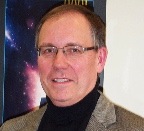|

|
Progress and Prospects for High-Resolution Imaging & Dispersive Spectroscopy for X-ray Astronomy
| Abstract: |
The impressive progress of observational high-energy astrophysics over the
past decade owes much to technology developed in the 1980's and 1990's.
I will review the CCD detector technology at the heart of current X-ray observatories, describe the most recent advances in X-ray CCD performance, and discuss the fundamental limitations of these detectors. I'll then survey efforts at MIT and elsewhere to surmount these limitations by adapting active pixel sensor architectures to the needs of X-ray astronomy, including our development of a three-dimensionally integrated
X-ray imager. I will also describe recent progress at MIT's Space nanostructures
Laboratory towards blazed transmission gratings for high-resolution dispersive spectrographs
for X-ray astronomy. I'll conclude with a discussion of the capabilities these technologies will ultimately
provide for the high-energy astrophysical observatories of the 2020s. |
| Speaker: |
Mark Bautz - MIT Kavli Institute |
| Speaker Bio: |
 Mark Bautz is a senior research scientist at the MIT Kavli Institute for
Astrophysics and Space Research (MKI), where he serves as Associate Director. He has been developing space instrumentation for X-ray astronomy for more than twenty years, and has contributed to instruments for ASCA (launched in 1993), Chandra (1999) and Suzaku (2005). He leads an X-ray detector development program at MKI and also conducts observational research aimed at understanding the astrophysics of galaxy clusters. Mark Bautz is a senior research scientist at the MIT Kavli Institute for
Astrophysics and Space Research (MKI), where he serves as Associate Director. He has been developing space instrumentation for X-ray astronomy for more than twenty years, and has contributed to instruments for ASCA (launched in 1993), Chandra (1999) and Suzaku (2005). He leads an X-ray detector development program at MKI and also conducts observational research aimed at understanding the astrophysics of galaxy clusters.
|
| Poster Link: |
Poster |
| Presentation: |
|
|
 Mark Bautz is a senior research scientist at the MIT Kavli Institute for
Astrophysics and Space Research (MKI), where he serves as Associate Director. He has been developing space instrumentation for X-ray astronomy for more than twenty years, and has contributed to instruments for ASCA (launched in 1993), Chandra (1999) and Suzaku (2005). He leads an X-ray detector development program at MKI and also conducts observational research aimed at understanding the astrophysics of galaxy clusters.
Mark Bautz is a senior research scientist at the MIT Kavli Institute for
Astrophysics and Space Research (MKI), where he serves as Associate Director. He has been developing space instrumentation for X-ray astronomy for more than twenty years, and has contributed to instruments for ASCA (launched in 1993), Chandra (1999) and Suzaku (2005). He leads an X-ray detector development program at MKI and also conducts observational research aimed at understanding the astrophysics of galaxy clusters.

